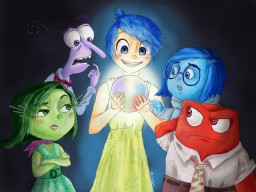Words of Wellness

July 10, 2015 | The Rev. Dr. Scott Stoner
Inside Out
Have you ever had the experience of having a "good cry," and then later find yourself feeling so much better? Or have you ever had the experience of having a "good fight" with a family member or friend, when you work through a conflict that has been building for some time and then find that you and the other person are both feeling renewed positive feelings toward each other? If so, then you would enjoy and identify with the wonderful messages that are taught in Inside Out, the new movie from Pixar animation playing in theaters now.Inside Out is the story of the inner, emotional life of an eleven year old girl named Riley. Riley's family uproots itself and moves from Minnesota to California because of her father's new job. Riley, understandably, becomes quite sad and angry as she misses her friends, school, and hockey team back in the Midwest. Riley's well-meaning parents don't like seeing her being upset and so they repeatedly encourage her to "focus on the positive" and want her to try to act happy on the outside even when she is not feeling that way on the inside.
The brilliance of this film is its portrayal of Riley's inner, emotional life. Through the magic of animation we are able to see inside Riley's brain where five characters (pictured above) represent five emotions (Joy, Sadness, Anger, Fear, and Disgust) that take turns controlling the keyboard of Riley's brain. Before her family's move from Minnesota Joy was clearly in control.
This all changes when the family moves and Fear, Sadness, and Anger start battling for control, with Joy ultimately being pushed out of the way. Riley's parents want Joy to be her prominent emotion and Riley clearly wants to please her parents. For this reason we see Joy doing everything she can to keep the other emotions, most especially Sadness, stifled.
But alas, the plan fails and Joy relinquishes control to Sadness. At that point it seems that Riley is doomed to a life of total sadness. It's just then that something surprising happens, something that is, in fact, the most important point of the movie. Once Riley embraces and allows herself to feel the sadness related to the move, she gradually begins to feel happier. There is a touching scene near the end of the movie when the animated characters Joy and Sadness both put their hands on the controls of Riley's inner, emotional keyboard. The message is clear for both children and adults who are watching-authentic joy and happiness occurs when we can integrate and feel all of our natural emotions.
Inside Out reminds us that all of our emotions are important, need to be heard, and serve important purposes. Our emotional wellness will be high when we can allow ourselves to both feel and express the full range of our emotions and it will be low when we try to block out or numb any of our emotions, as allowing the expression of all of our emotions brings openness and provides space for healing and growth. This is the paradox of emotional wellness, the paradox of what we mean when we talk about a "good cry" or a "good argument." When we allow ourselves to express what we tend to label as "negative" emotions, the positive emotions of joy and happiness often return and increase.
So, if you are in the mood for good movie that will provide plenty of good laughs along with a great message for kids and adults alike, I highly recommend seeing Inside Out this weekend.
Subscribe Now to Weekly Words of Wellness
Donít wait another day! Enter your e-mail address below to signup for the e-mail version of Weekly Words of Wellness. Rev. Dr. Scott Stoner covers a new topic each week providing insight and wisdom for our everyday lives.
You can unsubscribe at any time.

